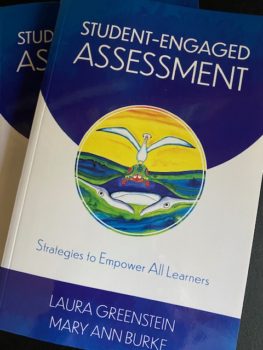How Students Assess Their Learning Outcomes
 How Students Assess Their Learning Outcomes
How Students Assess Their Learning Outcomes
This post is fourth of a series based on excepts from my book on Student-Engaged Assessment: Strategies to Empower All Learners by Laura Greenstein and Mary Ann Burke (2020). You can purchase the book from Roman and Littlefield for charts, examples, and worksheets on how to engage students to become owners of their learning successes.
Student Created Success Criteria
Students can vary in how they write their success criteria. At one end of the quality spectrum is the student who says, “I will write a mystery story. I will use adjectives to make it spooky.” Stretching beyond these foundations, another student may write, “I will write and edit a well-sequenced story that includes a coherent beginning, middle, and conclusion, utilize proper English conventions, and incorporate evidence of achieving the learning intention.”
Example of a Student Designed Self-Assessment Rubric
In science, a student-designed science experiment includes a definition of the problem, asks purposeful questions, clearly describes the process, reviewed current state of knowledge, their hypotheses, procedures, and results. The scoring rubric includes criteria for evaluating the statement of the problem, procedures followed, and the accuracy of interpretation of data. The table below shows an example of a student’s self-assessment rubric for evaluating readiness skills and alignment with the learning intention.
|
Rubric for my Project Points: 5 3 1 My Ratings & Insights
|
|||
| I checked my work for accuracy. | It looks like it’s accurate. | There may be some errors. | |
| I included all the required parts. | Most of the parts are included. | I think I missed some parts. | |
| I was self-reliant and asked for help as needed. | It’s mostly my work, but I got some help. | I needed some extra support and encouragement. | |
| My work shows effort. | I tried hard, but maybe not my best. | I put it together hurriedly. | |
| My work is complete.
|
My assignment is mostly done. | I skipped steps 3 and 5. | |
| Comments and Reflections:
|
|||
How Students Become Reflective Assessors
Assessment readiness requires more than academic qualities. Teachers must also consider students’ readiness that are relative to their academic foundations and motivations to learn. Teachers and their students can also reflect on their physical readiness, self-awareness, learning routines, preferences, and practices that support assessment readiness. Readiness can also be adaptable for individual school communities and schools as some settings rely on pertinent social skills and others focus more self-awareness and metacognitive skills.
As students mature, they develop clearer ideas about who they are and how they think. They also begin to identify their strengths and recognize personal struggles. This development of self-awareness and self-esteem can be fostered by assessments that encourage and guide students in monitoring their own learning. As students become reflective and flexible assessors, they can begin to personalize learning outcomes. For example, when given a choice to document their learning, Wei decides to make an instructive video, while Fiona illustrates a user’s guide to learning.
When Students Define Their Self-Assessment Tools
One day, Max said to his teacher, “I want to try something new for my project, but don’t want to be penalized for creativity since it’s the first time I’m using Piktochart, an infographic maker.” After a brief conversation, Max and his teacher mutually agreed to count the content ratings of the rubric at 90% and the design ratings at 10%. With the pressure off, Max is inspired to try something new.
In the classroom, numerous elements of assessment have been shown to increase student success. These include:
- Clarity of purpose
- Relevance to the learner
- Engagement
- Authentic experiences
- Personal reflection
- Informative feedback
- Reliance on consistent assessment
Teachers’ Observations of Student Self-Assessor Readiness
Teachers must rely on observing the outcomes (cognitive and emotional) of students’ learning. Students’ internal voices such as “I don’t care” or “I’ll try harder” are made visible through behaviors and products of learning. Sometimes, “Give it some more effort” or “I know you can do better” is often the default response. To boost success, it is more informative for teachers to ask “What do you want to learn about this topic?” or “What support and resources do you most need?” Teachers can clarify a student’s need for guidance by asking, “What is frustrating you right now?” or “How can I help you with your next step?” Developing a constructive outlook is the first step in helping students assess their own learning. Teachers must also consider their students’ assessment readiness through their comments, mindsets, and actions. Self-reflective questions may include:
- What does the pre-assessment data tell the teacher about the students’ knowledge, skills, interests, and readiness to move to the next lesson?
- How does this assessment data align to district mandated teaching standards and content?
- What are various options that students can use to demonstrate their learning outcomes?
Our November 23rd post will explain how students assess their learning outcomes. For more charts, examples, and worksheets on how to engage students to own their learning, you can purchase Student-Engaged Assessment: Strategies to Empower All Learners by Laura Greenstein and Mary Ann Burke (2020) from Roman and Littlefield.